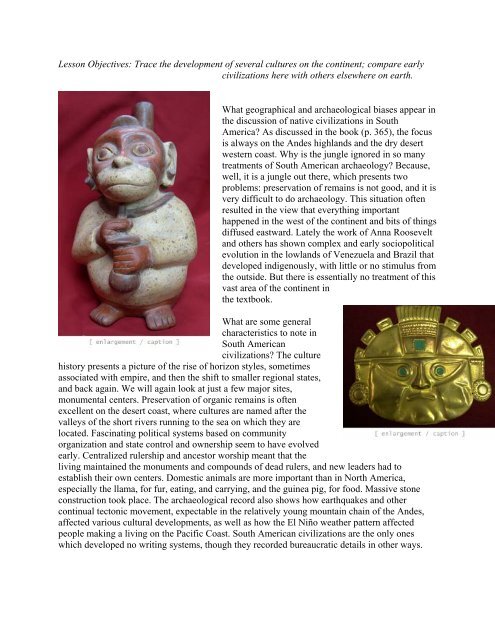INTRODUCTION TO ARCHAEOLOGY Nancy White - Touro Institute
INTRODUCTION TO ARCHAEOLOGY Nancy White - Touro Institute
INTRODUCTION TO ARCHAEOLOGY Nancy White - Touro Institute
Create successful ePaper yourself
Turn your PDF publications into a flip-book with our unique Google optimized e-Paper software.
Lesson Objectives: Trace the development of several cultures on the continent; compare early<br />
civilizations here with others elsewhere on earth.<br />
What geographical and archaeological biases appear in<br />
the discussion of native civilizations in South<br />
America? As discussed in the book (p. 365), the focus<br />
is always on the Andes highlands and the dry desert<br />
western coast. Why is the jungle ignored in so many<br />
treatments of South American archaeology? Because,<br />
well, it is a jungle out there, which presents two<br />
problems: preservation of remains is not good, and it is<br />
very difficult to do archaeology. This situation often<br />
resulted in the view that everything important<br />
happened in the west of the continent and bits of things<br />
diffused eastward. Lately the work of Anna Roosevelt<br />
and others has shown complex and early sociopolitical<br />
evolution in the lowlands of Venezuela and Brazil that<br />
developed indigenously, with little or no stimulus from<br />
the outside. But there is essentially no treatment of this<br />
vast area of the continent in<br />
the textbook.<br />
What are some general<br />
characteristics to note in<br />
South American<br />
civilizations? The culture<br />
history presents a picture of the rise of horizon<br />
styles, sometimes<br />
associated with empire, and then the shift to smaller regional states,<br />
and back again. We will again look at just a few major sites,<br />
monumental centers. Preservation of organic remains is often<br />
excellent on the desert coast, where cultures are named after the<br />
valleys of the short rivers running to the sea on which they are<br />
located. Fascinating political systems based on community<br />
organization and state control and ownership seem to have evolved<br />
early. Centralized rulership and ancestor worship meant that the<br />
living maintained the monuments and compounds of dead rulers, and new leaders had to<br />
establish their own centers. Domestic animals are more important than in North America,<br />
especially the llama, for fur, eating, and carrying, and the guinea pig, for food. Massive stone<br />
construction took place. The archaeological record also shows how earthquakes and other<br />
continual tectonic movement, expectable in the relatively young mountain chain of the Andes,<br />
affected various cultural developments, as well as how the El Niño weather pattern affected<br />
people making a living on the Pacific Coast. South American civilizations are the only ones<br />
which developed no writing systems, though they recorded bureaucratic details in other ways.
















